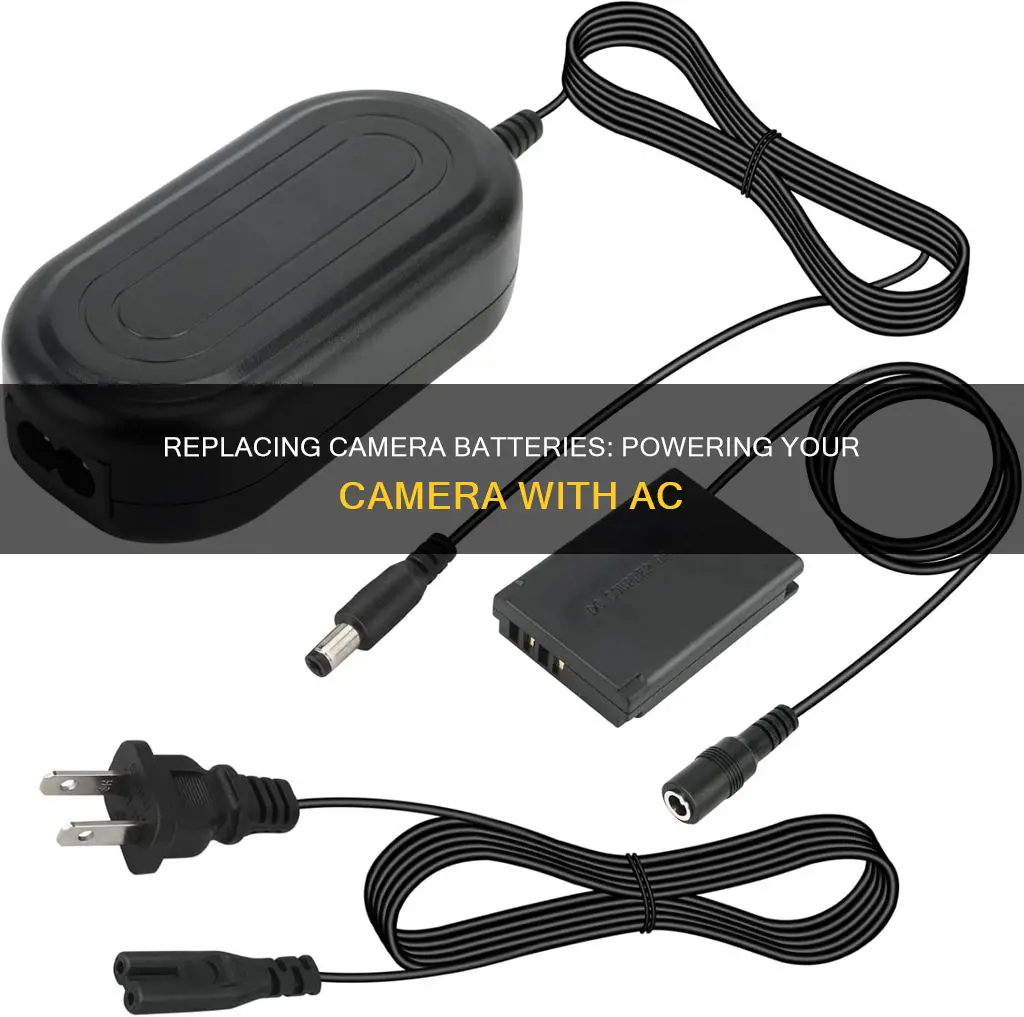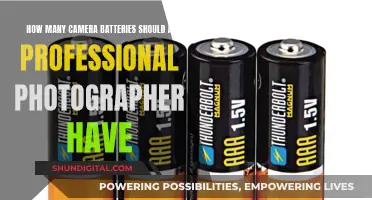
Replacing camera batteries with an AC power supply is a convenient way to ensure an uninterrupted power supply for your device. While most cameras are designed for portable power, using AC power can be more reliable and eliminate the need for frequent battery changes. This guide will introduce you to the process of converting your camera from battery power to AC power, ensuring a continuous and stable energy source for your device.
| Characteristics | Values |
|---|---|
| When to replace camera batteries with AC | When you need an uninterrupted power supply during shoots, or when you need to extend shooting time without relying on batteries. |
| What you need | An AC adapter or power supply unit designed for your camera model. |
| Compatibility | Check your camera model supports AC power input. Most DSLRs and mirrorless cameras have a dedicated port for AC adapters. |
| Voltage | Ensure the AC adapter matches the voltage of your camera. |
| Current | The AC adapter should be rated for the same current (amp/[mAh]) as your camera. |
| Connection | Connect the AC adapter to the camera's battery compartment or power input port, then plug the other end into a power outlet. |
| Safety | Ensure the camera is turned off before replacing batteries. Check the polarity of your camera's batteries and ensure the AC adapter matches to avoid damage. |
What You'll Learn
- Understand camera battery types and compatibility with AC power
- Steps to safely remove and replace camera batteries with AC
- Using AC adapters and power sources for camera battery replacement
- Ensuring proper voltage and current for camera battery replacement
- Using a dummy battery to connect the power supply

Understand camera battery types and compatibility with AC power
Understanding the different types of camera batteries and their compatibility with AC power is crucial for photographers who want to ensure a consistent power supply during shoots. Camera batteries are designed to provide portable power, but there are situations where using AC power is more convenient and reliable.
The most common types of camera batteries include lithium-ion (Li-ion), nickel-metal hydride (NiMH), and alkaline batteries. Li-ion batteries are widely used in modern cameras due to their high energy density and longer lifespan. However, they are generally not compatible with direct AC power, and a specific AC adapter is required. This adapter connects to the camera's battery compartment or power input port, providing a continuous power supply from a wall outlet. It is important to use an adapter that is compatible with your specific camera model to avoid any damage or malfunction.
Some camera models, especially professional ones, offer the option to use external battery grips or power packs that can be connected to AC power sources. These accessories can hold multiple batteries and provide extended shooting time, eliminating the need for frequent battery changes. Additionally, advancements in technology have led to the development of hybrid cameras that support USB charging or other power sources, allowing photographers to charge camera batteries using AC power through USB adapters or power banks.
When considering the compatibility of camera batteries with AC power, it is crucial to understand the voltage and current requirements of your camera. Standard dry-cell round batteries such as AAA, AA, C, or D are typically 1.5 volts each. To determine the total voltage of a device, multiply the voltage of a single battery by the number of batteries used. For example, four batteries would equal 6 volts, while six batteries would equal 9 volts.
In conclusion, by understanding the different camera battery types and their compatibility with AC power, photographers can make informed decisions about their power supply options. While most cameras require specific AC adapters, some models offer alternative solutions, such as external battery grips or USB charging. Ensuring the correct voltage and amperage specified by the camera manufacturer is crucial to avoid any potential damage to the equipment.
Disney's Camera Battery Chargers: A Photographer's Lifeline
You may want to see also

Steps to safely remove and replace camera batteries with AC
Step 1: Power Down Your Camera
Before you begin any removal or replacement, ensure your camera is turned off to prevent any potential damage to the device or batteries.
Step 2: Locate and Open the Battery Compartment
The battery compartment is usually found on the bottom or side of the camera and is often secured with a latch or screw. Refer to your camera manufacturer's instructions for the precise method to open it. This may involve sliding a latch, unscrewing, or pressing a release button.
Step 3: Remove the Old Batteries
Carefully remove the existing batteries, taking note of their orientation within the compartment. This is important as the new batteries must be inserted in the same way.
Step 4: Connect the AC Adapter
Use an AC adapter or power supply designed specifically for your camera model. Plug the adapter into the camera's power input port, ensuring a secure connection.
Step 5: Plug the AC Adapter into a Power Outlet
Connect the other end of the AC adapter to a functioning power outlet, ensuring the outlet provides the correct voltage as specified by your camera manufacturer.
Step 6: Power On and Verify
Turn on your camera and check the battery indicator to confirm it is receiving power from the AC adapter and no longer displays a low battery warning.
Additional Notes:
- Always refer to your camera's user manual for specific instructions and safety precautions.
- Keep spare batteries on hand in case of power outages or when shooting in remote locations without access to electricity.
- Regularly check your camera's battery and power supply for any signs of damage or wear to ensure optimal performance and longevity.
Reversing the Process:
To revert to using batteries, simply follow these steps in reverse. Disconnect the AC adapter from the power outlet and your camera, then insert new batteries into the battery compartment, ensuring they match the correct orientation.
Choosing the Right Charger for Your Camera: A Guide
You may want to see also

Using AC adapters and power sources for camera battery replacement
Understanding Camera Battery Types and Compatibility with AC Power:
Before opting for an AC power solution, it is essential to understand the different types of camera batteries. The most common types include lithium-ion (Li-ion), nickel-metal hydride (NiMH), and alkaline batteries. Modern cameras often use Li-ion batteries due to their high energy density and longer lifespan. However, these batteries are typically not compatible with direct AC power, requiring an AC adapter.
Steps to Safely Replace Camera Batteries with AC Power:
- Ensure your camera is turned off before removing or replacing batteries to prevent any potential damage.
- Locate the battery compartment, usually on the bottom or side of the camera, and open it according to the manufacturer's instructions.
- Remove the old batteries, taking note of their orientation for correct insertion of new batteries.
- Connect the AC adapter to your camera's power input port, ensuring a secure connection.
- Plug the other end of the AC adapter into a functioning power outlet with the correct voltage.
- Turn on your camera and verify that it is receiving power from the AC adapter by checking the battery indicator.
Utilizing AC Adapters and Power Sources:
- Check your camera's compatibility: Confirm that your camera model supports AC power input. Most DSLRs and mirrorless cameras have dedicated ports for AC adapters.
- Purchase the appropriate AC adapter: Choose an AC adapter specifically designed for your camera model to avoid damage or voiding the warranty.
- Connect the AC adapter to your camera: Locate the DC input port and plug in the adapter, ensuring a secure connection.
- Connect the AC adapter to a power source: Plug the adapter into a stable wall outlet or power strip.
- Power on your camera: Once connected, turn on your camera as usual. It should now be powered by the AC adapter.
- Adjust camera settings: Refer to your camera's manual for any recommended settings related to AC power usage.
Using AC adapters offers several advantages, including uninterrupted shooting sessions and a consistent power source. However, it's important to consider the limitations of AC power, such as restricted mobility and potential issues with power outages or unstable power sources.
Ensuring Proper Voltage and Current:
- Check the camera's power requirements: Refer to the user manual or the battery itself to identify the voltage and current specifications.
- Purchase a compatible AC adapter: Ensure the AC adapter matches the voltage and current requirements of your camera.
- Connect the AC adapter: Attach it to the camera's power input port, usually located on the side or bottom.
- Plug into a power source: Connect the AC adapter to a stable power outlet or strip, avoiding extension cords or fluctuating voltage sources.
- Test the connection: Turn on the camera and verify that it is receiving power and functioning properly.
While AC adapters offer a convenient alternative to batteries, it is always recommended to have spare batteries on hand for backup, especially when shooting in remote locations without access to AC power.
Crafting Camera Batteries: A Step-by-Step Guide
You may want to see also

Ensuring proper voltage and current for camera battery replacement
Ensuring the proper voltage and current for camera battery replacement is crucial to avoid damaging your equipment. Here are some detailed instructions to guide you through the process:
Understanding Voltage and Current:
- Voltage, measured in Volts (V), is like a ditch that traps your enemy. The bigger the ditch, the greater the potential or voltage.
- Current, measured in Amperes (A), is generated when your enemy falls into the ditch. It represents the flow of electricity.
- Power, measured in Watts (W), is the combination of voltage and current: Power (W) = Voltage (V) x Current (A).
- It's important to note that the measurement of voltage and current differs between Direct Current (DC) and Alternating Current (AC). DC is used in batteries and DC generators, while AC is used in portable AC generators and mains electricity.
Check Camera's Power Requirements:
- Refer to your camera's user manual or the battery itself to identify the voltage and current specifications.
- Ensure that the voltage matches the requirements of your camera to avoid any damage.
Choose the Right AC Adapter:
- Select an AC adapter specifically designed for your camera model to ensure compatibility and safety.
- Check the voltage and current ratings of the AC adapter to confirm they match your camera's power requirements.
Connect the AC Adapter:
- Locate the DC input port on your camera, usually on the side or bottom, and plug in the AC adapter securely.
- Ensure a stable and reliable connection to avoid power interruptions.
Plug into a Power Source:
- Connect the AC adapter to a power outlet or power strip.
- Avoid using extension cords or power sources with fluctuating voltage as they can damage your equipment.
Test the Connection:
- Turn on your camera and verify that it's receiving power from the AC adapter.
- Check if the camera functions properly and the battery is charging or being powered directly.
Maintain and Inspect:
- Regularly check your camera's battery and power supply for any signs of damage or wear.
- Proper maintenance and inspection can help prevent issues and ensure the longevity of your camera equipment.
It's important to note that while AC power is convenient, it's always recommended to have backup batteries, especially when shooting in remote locations or during power outages.
Charging Your Kodak Camera: A Step-by-Step Guide
You may want to see also

Using a dummy battery to connect the power supply
Using a dummy battery to connect your camera to a power supply is a convenient and reliable solution if you need to extend your shooting time or simply prefer not to rely on battery power. Here is a step-by-step guide on how to do this:
Step 1: Check your camera's compatibility
Ensure your camera model supports AC power input. Most DSLRs and mirrorless cameras have a dedicated port for AC adapters.
Step 2: Purchase the appropriate AC adapter
Buy an AC adapter specifically designed for your camera model. Using the wrong adapter can damage your camera or void its warranty.
Step 3: Prepare the dummy battery
You can make a dummy battery by taking a wooden dowel and cutting it into sections slightly shorter than your camera's battery. Drill a hole in the centre of each end of the wooden pieces to prevent the wood from splitting when you insert screws. Screw the screws in, leaving some room to wrap wire around them. Strip the insulation off several pieces of wire and wrap the bare wire around the screws, then tighten the screws to hold the wires in place.
Step 4: Connect the wires to the regulator circuit
Connect the positive output of the regulator circuit to one screw and the negative output to the other. Be sure to mark which end is positive and which is negative to avoid confusion when inserting the dummy batteries.
Step 5: Connect the AC adapter to the camera
Locate the DC input port on your camera and plug in the AC adapter. Ensure the connection is secure.
Step 6: Connect the AC adapter to a power source
Plug the AC adapter into a wall outlet or power strip, ensuring the power source is stable and reliable.
Step 7: Power on your camera
Turn on your camera. It should now be powered by the AC adapter.
Step 8: Adjust camera settings
Some cameras have specific settings related to AC power usage, so check your camera manual for any recommended adjustments.
Using AC power offers several advantages, such as eliminating the need for constant battery changes and providing a consistent power source. However, it does restrict mobility as you need to stay close to a power source. Additionally, in areas with power outages or unstable power, relying on AC power may not be feasible.
Charging Your 360 Fly Camera: A Quick Guide
You may want to see also
Frequently asked questions
You will need an AC adapter or power supply designed for your camera model. Connect the AC adapter to the camera's power input port and plug the other end into a power outlet. Ensure you use the correct voltage and amperage.
AC power provides a continuous power supply, eliminating the need for frequent battery changes. This is especially useful for extended photo or video shoots.
Always ensure your camera is turned off before attempting any battery replacement. Check the polarity of your power supply and match it with the polarity of your camera's battery compartment to avoid damage.
Determine the voltage (V) and current (mAh) requirements of your camera. Purchase an AC adapter that matches these specifications and is compatible with your camera model.







